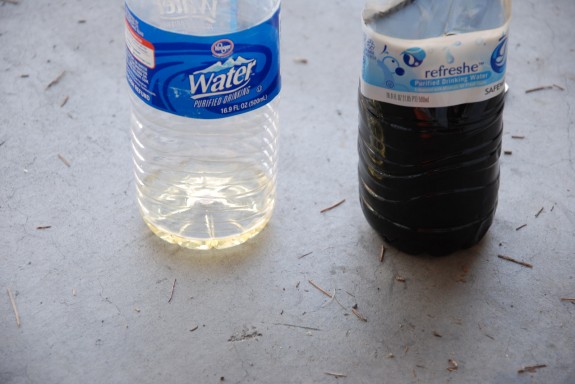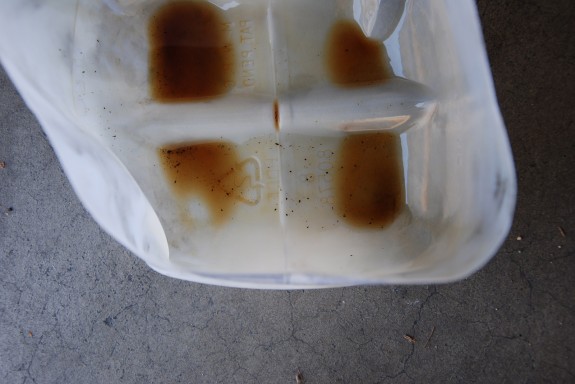Obscure Maintenance: Brake and Power Steering fluid
One of the first things that car owners ignore when gas prices start to climb are maintenance items that they don’t often hear about. Besides for oil and brakes, what else is there to do on a car that still runs great, right? Well, here is a little wake-up call for car owners of all kinds: the brake fluid and power steering fluid in your car is totally filthy, and if you don’t change them, they could cost you thousands down the road. I have no idea how this even happens, considering that the brake and power steering systems should be sealed with limited moving parts, so there shouldn’t be a whole ton of wear. But, if you still are not a believer, take a look after the jump to see exactly what I found in my all-highway-miles 2007 Accord.
As you can see above, there is a *slight* difference in the quality of new and used fluids. This particular picture is of my power steering fluid (the new stuff was poured into the water bottle to show color), but my brake fluid was the exact same way – light tan vs. pitch black. This wouldn’t be so bad if it were just black. After all, my diesel’s oil turns black with soot within 10 miles of a fresh oil change, but most used oil analyses agree that the color is irrelevant in that case. The worst part about dirty brake and power steering fluid is that they are also riddled with real chunks of crap! Just look below at what I found in my power steering reservoir:
Again, I have no idea why or how stuff like that would be in sealed systems, but it doesn’t seem uncommon. In fact, Honda’s service manual states that the reservoir actually has a strainer, and to replace the entire reservoir if the strainer is clogged. Some searches online indicate that even at 20,000 miles, people who do a brake fluid flush find blackened fluid with chunks like this. Thus, the smart money would bet on these chunks coming from “break-in” of new parts or just residue from manufacturing. Either way, get these out of your car ASAP!
There are several ways to change these fluids. The most obvious is to pay someone to do it, but that was out for me. My power steering reservoir was easily detached and the hoses were pliable enough to pour the fluid out, so that’s what I did. Considering the cheap cost of the fluid, I did this drain and fill procedure about three times. It didn’t change all the fluid, but it got rid of some along with the black specks, and that’s better than nothing. If you’re OCD, you can easily remove a hose from the reservoir, put it into a container and start the engine to activate the pump. This will pump the fluid out of the steering rack. I avoided this since I didn’t have help, the fluid can have bad effects on paint and plastic, and everything was just jammed into a bad spot.
For the brake fluid, most people use a turkey baster to suck the fluid out of the reservoir and replace with new fluid. This will replace most of the fluid in the brake system. Doing this once a year will keep the fluid fresh without costing much (maybe $10-20 a year). Just make sure not to remove too much fluid – if air is introduced into the line, you can lose a lot of braking power. Unfortunately, my reservoir was shaped in a way that doesn’t allow this. In cases like this, it will be necessary to bleed the fluid out from each brake caliper. This is somewhat of a pain, and a few things can go wrong. Since fluid is coming out from a caliper, the amount of fluid in the reservoir will be decreasing. If the reservoir isn’t kept full, air can get into the system and reduce your braking power. Also, the bleed valve on your calipers might be stuck, which is bad. Thus, for a full brake fluid flush, I’m going to go to the pros. My brakes are worth a few $$ to be done the right way.



